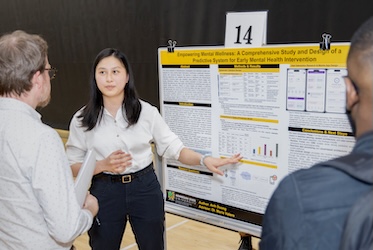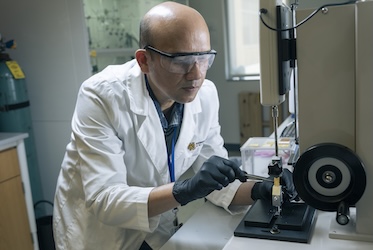
National Institutes of Health awards grant to study neuron activity
KENNESAW, Ga. | Feb 14, 2017
Neuroscientist Martin Hudson’s research could have ramifications for autism, other diseases

The National Institutes of Health (NIH) has awarded Kennesaw State University neuroscientist Martin Hudson $378,561 to research how neuron shape affects function and behavior in the nervous system.
“Martin Hudson’s research demonstrates the importance of fundamental scientific investigation,” said Mark Anderson, dean of the College of Science and Mathematics. “The impact of this work is both immediate in helping to advance basic micro- and cellular biology, and long-term in providing insight into how to diagnose and potentially treat disorders.”
Hudson’s research focuses on some of the most fundamental questions of developmental neurobiology and physiology. Among these are how defects in the development of the nervous system underlie many neurological disorders, including Parkinson’s disease, schizophrenia and autism.
Gaining a greater understanding of how a neuron’s shape may affect the nervous system could lead scientists toward discoveries that lessen the impact of these conditions in the future.
“My holy grail, what I’m searching for, is synaptic connectivity,” said Hudson, an associate professor of biology in the Department of Molecular and Cellular Biology. “For instance, how well do two cells talk to each other?”
According to Hudson, neurons can migrate long distances through the body both during and after embryonic development. In addition, neurons have to extend their axons over long distances towards their synaptic partners.
“Our goal is to identify the molecular cues that underpin these migrations, and to understand how these cues interact to govern nervous system development and function,” he said.
To better understand synaptic activity, Hudson is using microfluidic engineering and optogenetics to analyze the nervous system in C. elegans, a tiny and transparent worm. These tiny worms are powerful research tools that have been genetically modified with special fluorescent molecular tags that allow his team to monitor cell movement and their changes in form.
“By using microfluidics, we’re able to use small volumes of fluid and custom-manufactured chips with tiny channels that hold the worms,” he explained. “As we pass different stimuli over the worms – in this case, varying temperatures – we see how the neurons react.”
With optogenetics, a biological technique that uses light to control neurons, researchers can use different wavelengths of light to stimulate activation of one of the neurons to see how they respond.
“Optogenetics is really cool,” Hudson said. “We can use one wavelength of light to stimulate a neuron, and another wavelength of light to measure how that neuron responds and how its synaptic partners respond.”
By changing the shape and activity of neurons in a relatively simple animal like C. elegans, researchers can test hypotheses about how different cell parameters affect nervous system function in a controllable way. Because worms build their nervous systems much the same way humans do, the insights gained from this research can be applied to understanding human neurons and neurological disorders.
Donald McGarey, interim chair of the Department of Molecular and Cellular Biology and professor of biology, explained the funds from the NIH grant serve two purposes: scientific discovery and student intellectual and career development.
“Martin's research program has two major impacts,” McGarey said. “The first is the discovery of cellular factors guiding normal neuronal development and the defects that result from the alteration of these vital factors. The second is the mentoring of the next generation of neuroscientists by providing the opportunities for undergraduate and graduate students to work with him on the research.”
Robert S. Godlewski
Photos: David Caselli
Related Stories

Passions spark innovation at Kennesaw State Symposium of Student Scholars

Kennesaw State researcher tackling sustainability through use of transparent wood

Kennesaw State students to present research at Symposium of Student Scholars

Chemistry student engaged in sustainable catalyst research through Kennesaw State's First-Year Scholars program
A leader in innovative teaching and learning, Kennesaw State University offers undergraduate, graduate, and doctoral degrees to its more than 47,000 students. Kennesaw State is a member of the University System of Georgia with 11 academic colleges. The university’s vibrant campus culture, diverse population, strong global ties, and entrepreneurial spirit draw students from throughout the country and the world. Kennesaw State is a Carnegie-designated doctoral research institution (R2), placing it among an elite group of only 8 percent of U.S. colleges and universities with an R1 or R2 status. For more information, visit kennesaw.edu.














